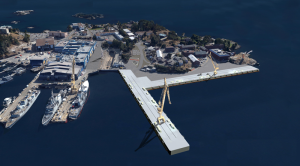Plans are well advanced to transform the Dockyard waterfront at CFB Esquimalt into a modern site for ship berthing.
Two projects are now beginning to move through the government’s project approval process: replacing “A” and “B” jetties in Constance Cove, and removing contaminated sediment from the harbour seabed.
When the design work and the necessary regulatory reviews are finalized, and once project approval is in hand, the A/B Jetty Recapitalization Project and the Esquimalt Harbour Remediation Project (EHRP) will hire the necessary contractors to start the work.
Clive Orford, Project Director for Naval Infrastructure in Ottawa, explains the projects are part of the broader master plan for renewal of infrastructure at the base that’s been unfolding over the past two decades.
“The A/B Jetty Project is a massive redevelopment of dockyard that has been anticipated for a generation, and is finally about to come to fruition once the final project approvals are in place in Ottawa,” he says.
As part of their good neighbour philosophy, DND is holding a Public Information Session for neighbours and those wanting to learn more about the projects on March 25, from 7 to 9 p.m., at the Songhees Wellness Centre, 1100 Admirals Road.
Questions may be posed to representatives of the project team from both Ottawa and Esquimalt.
Also available for viewing at the session will be the artist rendering, and information panels on the two projects. “A” and “B” jetties, originally built during the Second World War, are over 70 years old, which is well beyond their service life, and have many operational limitations.
Both structures are made of creosote-treated timber piles and beams, which, due to their age, have structural condition issues.
The A/B Jetty Recapitalization Project, which was announced by then Defence Minister Peter MacKay in February 2013, will provide structurally sound and technically appropriate berthing facilities for Canada’s current and future Pacific Naval Fleet.
Once complete, the new jetties will improve naval response preparedness, and increase operational efficiency for berthed vessels.
“The new jetties are being designed such that they should be able to withstand the forces of an earthquake or a tsunami,” says Orford.
The jetty recapitalization project involves the demolition of the existing jetties, and removal of the jetty cranes, utility services, and certain small buildings in the vicinity.
As the structures are removed, the seabed will be dredged and bedrock blasted within the construction zone to achieve sufficient water depth for ship berthing.
“B” Jetty will be replaced first, then “A” Jetty, Once the steel-encased concrete pile substructure, retaining walls and concrete service access tunnels have been built, the new concrete jetty decks will be added.
The future “A” Jetty will be 305 metres long, with a 22 metre wide deck, and it will be connected at its eastern end to “B” Jetty by an expansion joint.
The future “B” Jetty, slightly shorter in length at 274 metres long, will have a 26 metre wide deck.
In addition to the jetties, electrical substation buildings, a jetty services building, and two rail-mounted cranes will be delivered.
As the jetties are being re-built, the Esquimalt Harbour Remediation Project will be working in close coordination with the jetty construction project towards long-term health improvements of the marine environment in Esquimalt Harbour.
Contaminated seabed sediments at various locations will be dredged and near-shore contaminated sediments and soils capped.
All material removed will be transported for disposal at a facility authorized to accept it.
“Our still very active industrial harbour has been the location of naval operations for over 150 years, meaning that past practices have contributed to current contamination,” says Orford.
“Past practices of bygone days are not what they are at present and DND is very conscious today of being a first line environmental steward of the harbour.”
In support of the Esquimalt Harbour Remediation Project and jetty recapitalization project, CFB Esquimalt constructed a series of underwater reefs in 2012, compensating for any temporary disturbances to the marine habitat that may occur during the remediation and construction work.
“The EHRP is an example of DND’s ongoing management of the environmental health of the seabed and surrounding waters,” says Mike Bodman of the Formation Environment office, who is the Deputy Project Manager for the EHRP.
“Once implemented, the EHRP will reduce the exposure of marine life to contaminated sediment, and the re-built jetty structures will create a new habitat for diverse marine communities.”
While the construction and dredging work is under way, qualified environmental monitors will be present on site to help minimize sedimentation effects, as well as checking for fish and mammal presence.
The use of silt curtains during jetty removal, dredging, and blasting will assist in limiting sediment movement, while bubble curtains and fish exclusion methods will protect wildlife during blasting of the bedrock.
In-work water activities will be highly monitored, and will occur only when fishery conditions are deemed acceptable for the work.
Duane Freeman, the Formation Environment Officer, hopes that the upcoming public information session will allay the typical concerns that neighbours might have about the projects.
“We believe the impact on the general public will be limited, as the construction and dredging work itself will take place far from areas utilized by the public. We will be adhering to local noise bylaws and no negative health impacts are expected. As well, it will remain safe to swim, boat, or sail in Esquimalt Harbour outside of the marked safety zone,” he observed.
For updates on the jetty recapitalization project or EHRP, visit www.esquimaltharbour.ca.
Rachel Lallouz
Staff Writer












